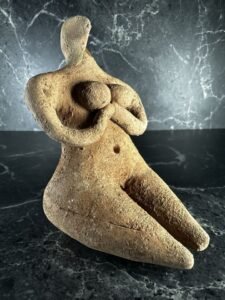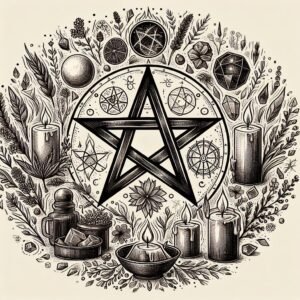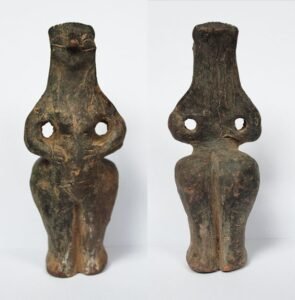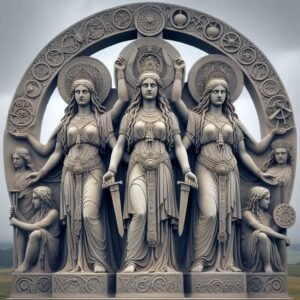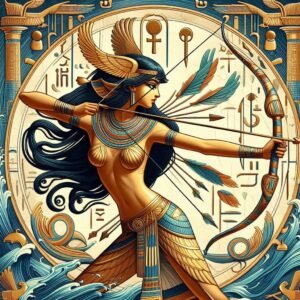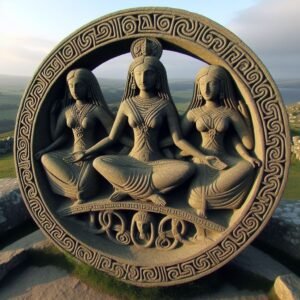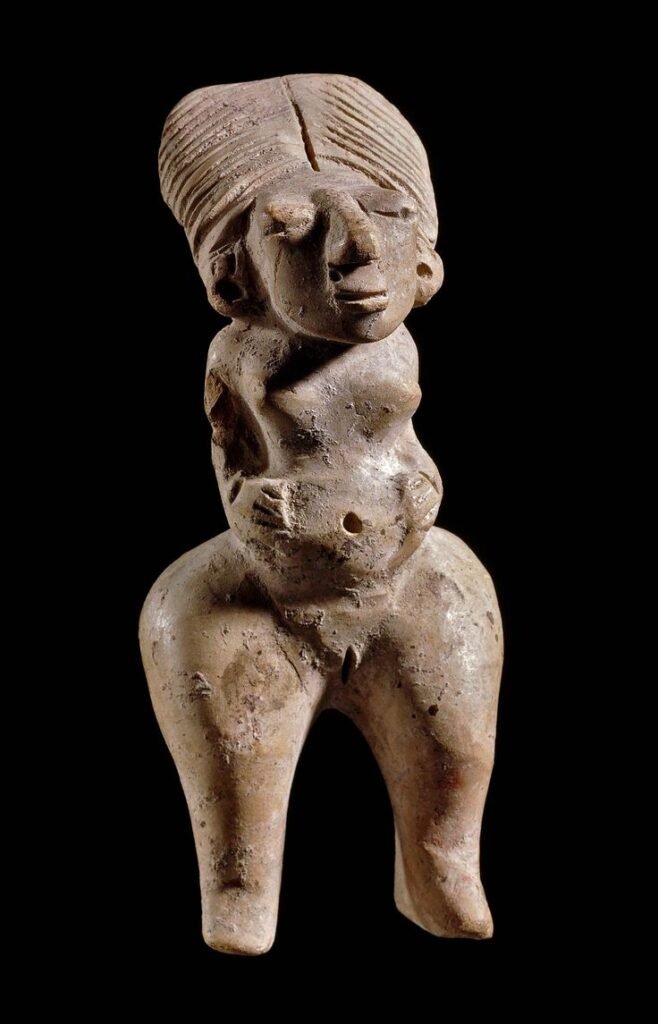
Mexican-mother-goddess Panuco River Mexico 15th 10th century BC British Museum
The mother goddess in Mesoamerica
“Small figurines are among the earliest expressions of figurative ‘art’ and appear independently in formative traditions elsewhere in the Americas. Exquisitely crafted female figures show pronounced hips and breasts with careful attention to the detailing of the hair, ear spools and necklaces. This woman holds her hands clasped to a swelling belly, conveying the sense that she is reflecting upon the new life gestating within. Panuco River, Mexico, 15th-10th century BC.” British Museum
The Mother Goddess archetype appears across a variety of ancient cultures, including in Mesoamerica, where figurines reflecting themes of fertility, motherhood, and the divine feminine have been found. The figurines from the Pánuco River area in Mexico fit within this broader pattern, emphasizing the nurturing, life-giving aspects of the feminine divine.
To expand on this, let’s explore other examples of similar figurines and evidence from Mesoamerican cultures that may help trace the continued presence of the Mother Goddess or feminine divine in this region.
Olmec Culture (c. 1200-400 BCE)
The Olmec civilization, one of the earliest major Mesoamerican cultures, left behind a number of figurines and stone carvings that are thought to represent female deities. Some of these figures display large, fertility-associated hips and breasts, as well as other symbols of motherhood and abundance.
Olmec Statuary: Several Olmec sculptures feature female figures with large breasts and exaggerated, round hips, which are symbols of fertility and nourishment. These statues are often thought to represent earth goddesses or fertility deities. Notably, the Olmec were some of the earliest in the Americas to create sculptural representations of divinities, many of which focus on fertility and agricultural abundance.
La Venta Figurines: Small ceramic figurines from the La Venta site in the Olmec region often show women with exaggerated reproductive features. These figurines are believed to have had a spiritual and ceremonial function, potentially used in rituals to honour the goddesses of fertility and the earth.
Teotihuacan (c. 100 BCE-750 CE)
While the Olmec were foundational in the development of Mesoamerican religious practices, the Teotihuacan civilization, known for the Pyramid of the Sun and Pyramid of the Moon, also had representations of female figures that likely played significant roles in fertility, childbirth, and the earth.
Teotihuacan Figurines: Figurines from Teotihuacan (mostly found in temples and burial sites) depict females with large breasts and bellies, symbolizing the fertility of the earth and women. Many of these figures are often dressed in ceremonial garb, and the exaggerated features are likely connected to fertility rituals or honouring feminine divinity.
The feathered serpent god Quetzalcoatl is often depicted in connection with both fertility and agriculture, which may link the feminine and masculine aspects of creation in Teotihuacan’s mythology.
The Maya (c. 2000 BCE – 1500 CE)
The Maya civilization developed a rich and highly sophisticated belief system that included a number of fertility goddesses and other feminine deities. Many of these figures, such as Ix Chel, were associated with the moon, love, fertility, and medicine, and were often depicted with prominent breasts, symbolizing fertility and the nourishment of life.
Maya Figurines: Small Maya figurines, often made from ceramic or jade, depict goddesses with large breasts and swelling bellies, often holding their own breasts or emphasizing the nurturing, life-giving force of the feminine.
The Maya goddess Ix Chel, in particular, is often depicted as a powerful maternal deity associated with fertility, childbirth, and the creation of life. She is one of the more well-known deities who embodies the mother goddess archetype in Mesoamerican mythology.
The Zapotec and Mixtec Cultures (c. 500 BCE – 1521 CE)
In the Zapotec and Mixtec civilizations of ancient Oaxaca, Mexico, figurines that likely represent fertility goddesses have been found. These cultures were known for their artistic depictions of deities, including goddesses associated with agricultural fertility, childbirth, and the earth.
Zapotec Figurines: Small ceramic figurines from Zapotec sites show women with large breasts and swollen bellies, often holding their breasts or bellies, symbolizing fertility and the creation of life. These figurines were likely used in ceremonial practices to honour fertility and the earth’s abundance.
Mixtec Art and Figurines: Similar figures from the Mixtec culture depict female deities with pronounced reproductive features. These figures, found in tombs and burial sites, likely represented goddesses of fertility and the protection of life.
The Mesoamerican Concept of the Earth Goddess
Across various Mesoamerican cultures, the Earth Goddess is often associated with the Mother Goddess figure. In many myths, the Earth itself is seen as a maternal figure that gives birth to all life, and the idea of fertility, regeneration, and nourishment is closely tied to the cycles of the earth.
Quetzalcoatl and Coatlicue: Figures like Coatlicue, the Aztec Earth Goddess, often depicted with a serpent skirt and fertility symbols, embody the connection between life and death. Coatlicue represents both creation and destruction, symbolizing the earth’s ability to give birth to new life, but also to reclaim it.
Summary of Findings
Mesoamerican Cultures: There is consistent evidence of goddess figures with exaggerated reproductive features across a variety of Mesoamerican cultures, including the Olmec, Teotihuacan, Maya, and Zapotec. These figures are often associated with fertility, nourishment, and the earth.
Symbolism: The large breasts and swollen bellies of these figures consistently symbolize the fertility and nurturing power of the feminine divine. Whether represented as Earth Goddesses or fertility deities, these figures align with the broader Mother Goddess archetype seen in many ancient cultures.
Archaeological Evidence
Figurines found in these cultures often carry symbolic elements, like ear spools, necklaces, and hands clasped over the belly, conveying themes of fertility, creation, and the nourishing aspects of the divine feminine.
Whilst my own investigations continue, and it is very difficult to belief any definitive evidence of such a suggestion might be found simply due to the lack of evidence. However, from my own perspective, this concept of a global Mother Goddess cult that believed it was a Goddess that is the source of creation as we know it, seems a strong one. As is the notion that it used very similar iconography and conceptualisations, which started quite vague and simplistic, but developed in complexity over time, and existed from the Palaeolithic to at least the end of the Bronze Age. This came to be replaced, often by force, by a patriarchal focussed cult which has resulted in most of the worlds religions we see today.
Subscribe to our post updates - Don't miss a thing!!

